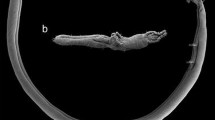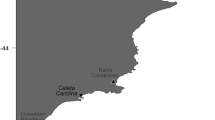Abstract
The mobility of Anomia chinensis Philippi was studied in relation to its byssal development stage. This species shows high mobility even after it begins cementation in its post-larval stage. Juveniles develop a calcified byssus in the post-larval stage and cement to substrata. However, juveniles up to about 10 mm in shell length can relocate by repeating a sequence of formation of the calcified byssus, abandonment of it, locomotion by crawling, reattachment, and recementation. Juvenile anomiids up to 25 mm in shell length also can move, without breaking their byssal attachments, by shifting the center of byssal calcification dorsally. Even an adult can change its orientation by forming a twisted byssus. These possible methods of movement are closely related to five stages of byssal development. Anomiids can use this mobility to seek a preferable position for attachment after initial cementation, or to adjust their orientation, and thus promote higher survivorship.
Similar content being viewed by others
Author information
Authors and Affiliations
Additional information
Received: 18 August 1997 / Accepted: 19 July 1998
Rights and permissions
About this article
Cite this article
Yamaguchi, K. Cementation vs mobility: development of a cemented byssus and flexible mobility in Anomia chinensis. Marine Biology 132, 651–661 (1998). https://doi.org/10.1007/s002270050430
Issue Date:
DOI: https://doi.org/10.1007/s002270050430




